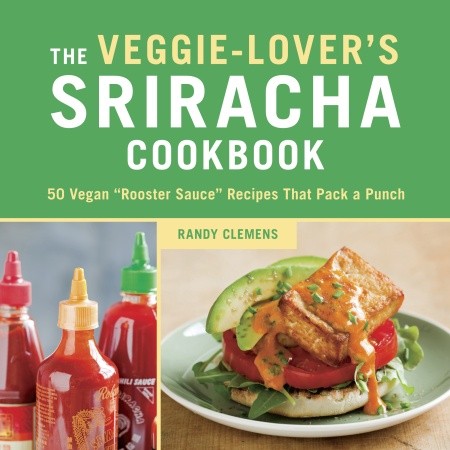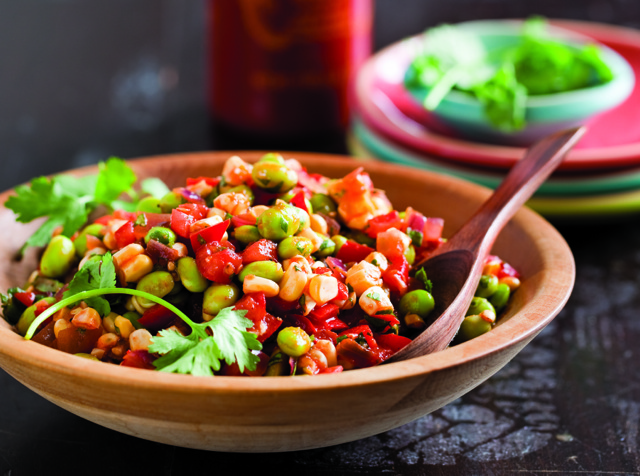
bookcover, l
(article, Vijaysree Venkatraman)
[%pageBreakSettings nobreak=true][%adInjectionSettings noInject=true] p(blue). A food writer based in southern California, Randy Clemens is best known as the author of The Sriracha Cookbook. This 2011 cookbook is dedicated to cooking with a southeast Asian sauce named after its Thai town of origin, Si Racha. In the U.S., the chile-and-garlic sauce is frequently referred to as "rooster sauce," after the bird logo on the most popular brand, made by the California-based Huy Fong Foods. p(blue). In recent years, Sriracha has become so trendy that, in 2010, Bon Appétit magazine dubbed it the '"Ingredient One year later, The Sriracha Cookbook was such a hit that Clemens wrote a vegetarian sequel, out this month: The Veggie-Lover's Sriracha Cookbook. Both books use the spicy, garlicky condiment as a central ingredient in a wide variety of dishes, from appetizers through main dishes and even dessert. [[block(sidebar). h1.Featured recipes]] You are a graduate of the California School of Culinary Arts. When and where did you first encounter Sriracha? When I was in high school, I became very close friends with a Vietnamese guy named Phi Nguyen. We were in marching band, and we ended up spending quite a bit of time together. I started hanging out over at his house, and I instantly fell in love with his mom’s cooking. Vietnamese food was something I’d never experienced before, and now I couldn’t get enough of it! One time, I stayed over at his place and awoke to find his mom had made cơm chiên (fried rice) for breakfast, and it was divine. Sitting inconspicuously on the table was this interesting bottle of hot sauce that caught my eye. No one else was touching it, nor did they say I should try it, but my curiosity got the best of me. A little squirt . . . a big bite . . . and hallelujah! The clouds parted, the sun shone, and my new life began. [%image reference-image float=right width=400 caption="Randy Clemens"] Tell us more about the history of this sauce in America. Sriracha is actually a Thai style of hot sauce of fermented chile peppers, garlic, vinegar, salt, and sugar. The Huy Fong Foods brand that most of us know and love uses red jalapeños and adds a few preservatives, but there are other brands here in the U.S. and in Thailand that incorporate different peppers. “Rooster” sauce made its way to America via David Tran, a Vietnamese refugee who settled here in the late 1970s and began making chile sauces in Los Angeles soon after, with $50,000 he gathered from his friends, family, and his own life savings. So the condiment has been in the U.S. for about 30 years now. I’d love to meet the banker that denied his request for a business loan way back then! How did it become so trendy without advertising on television or, more recently, social-media efforts? It is popular because it’s delicious and it has, to my mind, just the right level of heat. It’s almost too hot for a lot of people, but it never crosses that line. Plus, it’s got this kind of mysterious cult-like following that I think people like being a part of. For a long time, if you found a bottle of Sriracha at a friend’s house, it was like you both knew the same secret handshake. Sure, I suppose there are plenty of people who can point to it and say it’s trendy. You read about it a lot, and it’s gotten its share of over-the-top reactions. For instance: "OMG THIS IS THE GREATEST THING EVAR!!!! MOAR SRIRACHA ON EVERYTHING!!!!" But for me, it’s tried and true. Fifteen years now, and I still enjoy it each and every day — as a condiment on my food, but also as an ingredient in my food. There is a wonderful The Oatmeal cartoon about Sriracha that says: “You are a delicious blessing flavored with the incandescent glow of a thousand dying suns.” Hyperbole or a good description of the sauce’s potent taste? Nothing but love for The Oatmeal and his art! I think it’s definitely some hyperbole (this is The Oatmeal we’re talking about here), but at the same time, it rings true for a lot of people. When you like how this sauce interacts with — and enhances the flavors of — everything you add it to, why not go a little overboard in singing its praises? [%image succotash float=left width=400 caption="Edamame Succotash, from The Veggie-Lover’s Sriracha Cookbook."] What did your friends say about your work on the first Sriracha cookbook, and now the next one? My friends knew my affinity for Sriracha, and they weren’t at all surprised that I was interested in writing about it. I’d been cooking with it for years, and it was great to have their support. About three years ago, I read Eating Animals, by Jonathan Safran Foer, and realized that it’s reprehensible to think that we can decide it’s OK to kill another sentient being. I am a vegetarian now, but I did develop, write, and test the recipes in the first book. I’m still very proud of it, but you won’t find me cooking the meat dishes any longer. There are some good veggie meals in there that are still among my favorites, like the Fire-Roasted Sriracha Corn Chowder. In this new book, the recipes are all about the almighty vegetable and how wonderful it can be with a healthy dose of Sriracha without resorting to those soy-based meat substitutes. [%image bookcover float=right width=300] Your new book has recipes ranging from Sriracha-Cucumber Hummus to Maple-Sriracha Donuts. Is there any food item that cannot benefit from a touch of this fiery, garlicky sauce? Well, I’ve never had success with ice cream. It works great for me in sorbets. But in ice cream — no. Not to say it can’t be done — it has — but I haven’t enjoyed any of the results when I tried making it. Is the Sriracha flavor becoming mainstream? Has it spawned any byproducts? I think there are some companies out there trying to capitalize on Sriracha’s success without being true to it. Here’s a case in point: Lay’s Sriracha Potato Chips. Tasty? Meh. They’re OK. They offend me because one look at the ingredients list and you see they’re more of a food chemist’s wet dream as opposed to any kind of homage to the almighty rooster sauce. Pei Wei and Subway are dabbling in making Sriracha dishes at their chains. Plenty of restaurants and food trucks around the country are using Sriracha in their recipes. Then, there are all sorts of Sriracha-themed trinkets out there: underwear, lip balm, chocolate truffles, bitters, iPhone cases, you name it! But here's the cool thing: Smaller producers are making their own small-batch versions of Sriracha, such as Jojo’s Sriracha from Brooklyn, and Copperpot’s Sriracha, from just outside of Miami. [%image sangria float=left width=400 caption="Watermelon Sriracha Sangria, from The Veggie-Lover’s Sriracha Cookbook."] Have you made a pilgrimage to the home of Sriracha yet? Well, I was fortunate enough to visit the Huy Fong Foods factory in Rosemead a few years ago. I could smell it from down the block. They’re currently moving to a new facility in Irwindale, which I haven’t seen yet, but I heard it’s incredible. I’ve also made the bigger pilgrimage, going to the town of Si Racha in Thailand. That was a surreal experience, and it was great to have the Thai versions straight from the source. The sauce is nothing like the Huy Fong Foods version. Thai Sriracha is a little sweeter and has a much thinner consistency. I love both styles, but they are decidedly different from one another. Shark Brand and Sriraja Panich are my favorite Thai bottles; try them out if you’re curious. p(bio). Vijaysree Venkatraman is a Boston-based science journalist.

bookcover, l

reference-image, l

sangria, l

succotash, l